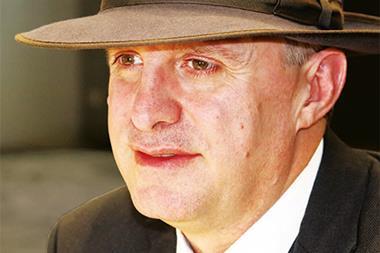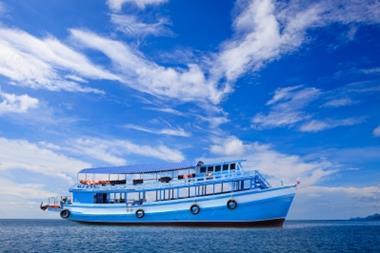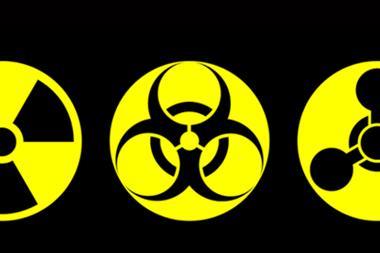PIERRE SONIGO: Do you believe, Arie, that you have good control over your environmental risks?
ARIE J VAN DER STEEN: We have been through a lot of acquisitions and divestments in the last 20 years or so. Basically, our environmental liability risks are associated with really old operations – they are historic liabilities. When we buy and also when we divest we try to make an inventory of all those liabilities so I think we have been managing this already for many years. What is a new development is that basically the liabilities now have to be very well documented, and have to be very well based on evidence. But new conditions come in and there we find of course some surprises, for example that people at sites were declaring provisions without an adequate basis. So we have to go back and work out more details about what the exact liability was because it was just an estimate. But if you look at the company as a whole, the total liabilities are not changing that much.
HANS BRANDT: How far back do you go, if you buy a company?
ARIE J VAN DER STEEN: We have sites that go back 100 years.
DIDIER MELLAERTS: We have the same.
ARIE J VAN DER STEEN: Some go back 150 years, like old coating sites along the River Thames where the old shipyards were. All the sites that we have that were built after the 1970s are pretty clean. We feel we have a decent overview of those liabilities, but you have to manage it continuously.
HANS BRANDT: Have you had any legal cases where you’ve been able to use the material you’ve put together to prove that you are not guilty?
ARIE J VAN DER STEEN: It is a question of transparency and if you want to show what is there. Sometimes we also have plants with contamination in the ground that we didn’t know about when we bought them, and then it is discovered and the old companies that we bought the plants from do not exist any more. So then it is your problem. You have to deal with the legal authorities and make the necessary arrangements, and it can be quite costly. We always do due diligence for acquisitions and it has to be very good, so we use highly respected companies for that. It can be quite tricky.
PIERRE SONIGO: We know how to deal with mergers and acquisitions now but in the past companies would often sell a plant and keep the environmental liabilities - they were not aware of the need to try to transfer those liabilities because nobody worried about them - and that creates a lot of problems now.
ADRIAN CLEMENTS: But can we guarantee that the contracts that are being set up by the legal department are actually correct? It can happen that although you have a standard contract which says that you sell all liabilities with the plant, in order to sell the plant there are some changes made. And the risk manager may not be part of that last decision making process. Even though the contracts are corporate documents, signed and agreed upon, the final wording is agreed when the actual negotiations take place. We are not there so we don’t know what liabilities have been sold. Either you take the time to follow up on every contract, which I would say is impossible, or you live with a residual risk, and you are going to get hit one day.
PIERRE SONIGO: It is a very difficult issue. In our department we have been able to enforce the policy that a member of our department should always be included in the due diligence team because, as you say, the contract is often changed at the last minute and environmental issues can be very tricky. So one way to avoid this problem is to insist on being a member of the environmental due diligence team.
ARIE J VAN DER STEEN: It’s the same in our company. There is always one member in there as the environmental specialist.
PIERRE SONIGO: He reads the contracts?
ARIE J VAN DER STEEN: He sees the contracts and the progress.
PIERRE SONIGO: That is how we learn, we learn from our past errors by doing that.
ARIE J VAN DER STEEN: Because at the last moment if anything changes, if the commercial guy thinks it is fine …
PIERRE SONIGO: And if the lawyer thinks it is fine …
ADRIAN CLEMENTS: It is fine from his viewpoint!
HANS BRANDT: Within my company I would say we have fairly good control. We run buses, ferry companies, trains, etc, and buy bus companies and ferry companies. Of course, you cannot know for sure what they did in those companies many years ago. As regards train services, we lease trains and run them on a contractual basis for two or three years on a certain railway and this can present a new problem. If in five or 10 years time, we are accused of having had an oil leakage on the railway, how can we be sure it was us because other operators were running services on that railway before and after us? I think that will be an increasing problem in today’s Europe when a lot of transportation is no longer monopolistic, it is put out to contractors like ourselves. Another small problem we encountered in one country involved an accusation of a tram causing noise. I don’t know if that is an environmental claim, it may be. Then of course, in addition to that and it doesn’t involve my company’s activities, there are the things like electromagnetic fields and what our mobile phones may be doing to us, so that is a new area. As I said, I think my company has very good control but as long as we are contractors for a certain time then there might be problems.
PIERRE SONIGO: From the insurance point of view, do you feel that the people who need to buy some environmental liability protection have enough information about the risk? Can we quantify the risk? Can we give you all the information that you need to underwrite the risk?
KARL RUSSEK: Typically, the scenario that we see involving a large company is that there is a particular transaction, perhaps a steel mill that it is trying to sell, and the deal gets bogged down at the last minute over environmental issues. We have found when we are seeing them at that stage, and it is towards the end of the deal, the risk manager isn’t even involved. The risk manager may be asked at the last minute to review this insurance policy that the commercial people and the lawyers have come up with as an idea to help salvage the transaction. So there is insurance being used as part of these transactions either on behalf of the divesting company or on behalf of the buyer of the property in order to help digest the environmental risks associated with these transactions that the risk manager of the department may not even be aware of, in some cases not until after the fact, because it tends to be driven by the lawyers, by the deal people, and in some cases by the bank who are the private equity fund buying the property. There are so many different moving parts that it is very difficult to keep tabs on it.
ADRIAN CLEMENTS: Because people are buying insurance it would imply that they have done a risk appetite type of calculation, that they know what they are doing, but I personally have the feeling that a lot of companies, maybe not the big ones but the others, don’t really know how to quantify that risk. So they want to buy insurance to transfer all the risk and I would expect that the insurance company will not like that, or increases its prices, or adds clauses. If you want to reinsure or insure a company which knows its risk, has quantified it, has its own risk appetite, that surely that would make your risk appetite better?
KARL RUSSEK: Generally when we see a transaction, because it is typically some sort of property transaction or corporate transaction, the level of due diligence that has been performed is quite good, it is up to normal standards. it depends on the industry. I would say if it is an industry which has had historic awareness of environmental issues like steel, non-ferrous metals or chemicals or what have you, the EHS departments in those companies are generally quite good at finding the right vendors to do the due diligence. In those circumstances it usually comes down to a couple of isolated issues where there may be a grey area. But we do see companies who come in and are evaluating the use of insurance who have done virtually no due diligence and who think that they can simply transfer all the risk. That is not the case. Frankly it is the more educated buyers with whom we have more success because they understand the risk, they understand what is insurable and what is not. I would say it is increasingly insurable as due diligence becomes more and more standardised and as the regulatory situation comes into focus in the various jurisdictions.
ADRIAN CLEMENTS: Do you have blacklisted countries? Generally we have been talking about the western world but most of us are expanding in other areas.
KARL RUSSEK: North America, most of Latin America, EU - the list is growing where we are quite comfortable. We can generally provide some degree of coverage worldwide, where we are allowed to sell insurance, but am I going to cover the environmental legacy for a former state-owned steel mill in China? Likely not. At the same time, we are seeing risks in Eastern European countries where obviously the history of compliance has not quite been what it is in western Europe or North America, but where the standard of due diligence applied is quite good. So we can understand very well what is likely to be under the site, even though the due diligence may have been more difficult because you don’t have the records of compliance necessarily. There are many variables.
ADRIAN CLEMENTS: You mention contaminants below the ground, but you also have to look to your waterborne and airborne substances. Environmental covers everything. How do you know what came out of the top of a blast furnace maybe 30 years ago? Maybe it was not so nice but it landed 10km away. So would you expect to have these due diligence reports covering a 10km or 20km radius? Similarly, the steel industry pumps a lot of cooling water back into rivers, so a problem may be 30km downstream. Is that something you cover - something you can handle?
KARL RUSSEK: It is a function of how well it is understood. Do you know what the current state is? Do you know how long this has been the case? There’s also the question of what jurisdiction you are in. You may have a discharge into a river that has been permitted for 30 years in western Europe but is now something that is likely to be looked at in a biodiversity context - the question of the thermal discharge as opposed to the actual permitted chemical levels, and things like that.
It’s also a question of scale. What is the likelihood? In many cases, we are underwriting it as a political risk policy, not only what is the likelihood something will be required through the letter of the law, but also what is the likelihood you are going to be a target. And you get into the CSR type questions. Are you seen as a good actor in the community or are you seen as a perennial compliance problem that the regulators are likely to want to make a target of? Frankly they sound like soft qualitative issues but they are the type of issues we are taking into account when we are underwriting and deciding whether or not we want to accept the risk.
PIERRE SONIGO: Some people in the report said it was difficult to get coverage and you said, Tomasz, that that’s the case apparently in Poland. Can you comment on that, please.
TOMASZ MIAZEK: First, we are fully complying with all the regulations about environmental risk so we feel very comfortable, but we plan to sell some of our buildings. It’s a trend in the telecoms business to sell buildings because electronic equipment is getting smaller and smaller so we don’t need to a lot of buildings any more. So I am interested in how insurance can help potential buyers to be comfortable about potential risks. Is it possible to cover any of the environmental risks? I thought the only possible insurance was civil liability - sudden and accidental cover - which is not really what we are looking for.
KARL RUSSEK: Typically, when we are looking at it in the context of a corporate transaction, historic unknowns are the first things people are looking to have covered. They’ve done some degree of due diligence but some surface investigation is inherently imperfect, you can’t know everything that’s under a site. If a reasonable degree of due diligence has been performed, we can provide a policy that will respond in the event that something is discovered after the property has been sold off.
TOMASZ MIAZEK: Would you cover the disposal of asbestos which was not discovered during the due diligence?
KARL RUSSEK: Asbestos in structures is a particularly difficult question. Typically, what we are dealing with is soil and ground water contamination, surface water contamination. Also, particularly as we look at different jurisdictions where we are not seeing a US style regulatory regime, more and more we are being asked to provide, and are providing, coverage for third party liabilities associated with known historic conditions. For example, you may have a soil or ground water condition that is well managed, it is being cleaned up, but there maybe some inherent third party bodily injury or diminution of property value risk or something like that, more of a financial exposure associated with a known clean-up obligation. Something like that can also be covered along with, as Pierre mentioned earlier, capping the actual cost of clean-up itself. All of these things are a function of how much information you have on the properties















